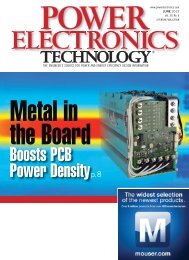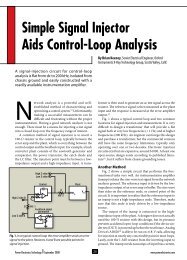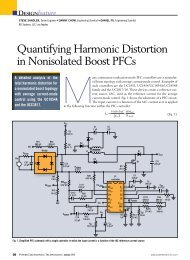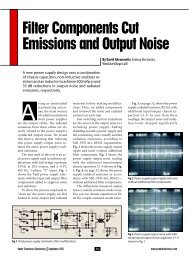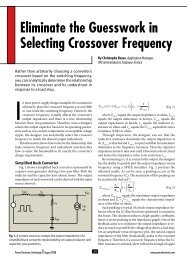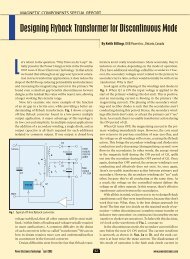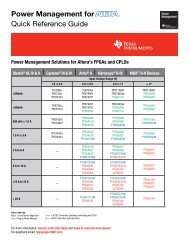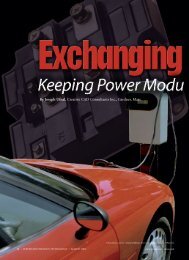Charge Your Battery Faster By Using a USB Port - Power Electronics
Charge Your Battery Faster By Using a USB Port - Power Electronics
Charge Your Battery Faster By Using a USB Port - Power Electronics
You also want an ePaper? Increase the reach of your titles
YUMPU automatically turns print PDFs into web optimized ePapers that Google loves.
Ac adapter<br />
3.7 V to 7 V<br />
350 mA<br />
charge<br />
<strong>USB</strong><br />
3.7 V to 6 V<br />
100 mA<br />
charge<br />
Dc input C1<br />
up to 4.7uF<br />
6.5 V.<br />
protected<br />
to 18 V<br />
Q1<br />
FDN302<br />
<strong>USB</strong> input<br />
Dc input C1<br />
up to 4.7uF<br />
6.5 V.<br />
protected<br />
to 18 V<br />
<strong>USB</strong> input<br />
<strong>USB</strong> PORT<br />
C1<br />
1uF<br />
C2<br />
1uF<br />
Dc<br />
<strong>USB</strong><br />
Gnd<br />
Q2<br />
FDN302 R1 1k<br />
C2<br />
1uF<br />
R2 10k<br />
4.7uF<br />
to Ref<br />
R3<br />
100 k R4<br />
1% 300 k<br />
1%<br />
Q1<br />
FDN302 R1 1k<br />
C2<br />
1uF<br />
C3<br />
4.7uF<br />
to Ref<br />
R2<br />
100 k<br />
1%<br />
U1<br />
Max1555<br />
R3<br />
300 k<br />
1%<br />
<strong>Charge</strong><br />
control<br />
Dc<br />
Dcok\<br />
Dclv<br />
Uok\<br />
<strong>USB</strong><br />
Dci<br />
<strong>By</strong>p<br />
C4<br />
2.2uF<br />
Dc<br />
Dcok\<br />
Dclv<br />
Uok\<br />
<strong>USB</strong><br />
Dci<br />
Chg\<br />
<strong>By</strong>p<br />
C4<br />
2.2uF<br />
C3<br />
1uF<br />
U1<br />
Max1874<br />
<strong>Charge</strong><br />
control<br />
<strong>Charge</strong><br />
control<br />
D1 MBR0520L<br />
D2 MBR0520L<br />
Pon<br />
Batt<br />
Chg\<br />
En<br />
UseL<br />
Ref<br />
Thrm<br />
Pgnd Gnd<br />
U1<br />
Max1874<br />
1-cell<br />
Li-Ion<br />
Pon<br />
Batt<br />
Chg\<br />
En<br />
UseL<br />
Ref<br />
Thrm<br />
Pgnd Gnd<br />
C5<br />
2.2uF<br />
D1 MBR0520L<br />
U2<br />
Max8881<br />
EUT33<br />
In Out<br />
Shdn\ Fb<br />
Pok<br />
Gnd<br />
C6<br />
2.2uF<br />
500 mA<br />
100 mA<br />
To<br />
system<br />
load<br />
Q3<br />
FDN302<br />
C6 R6<br />
0.1uF 10k 1%<br />
750 mA-hr<br />
to 2 A-hr<br />
Li-Iion cell<br />
Q2<br />
FDN302<br />
500 mA<br />
100 mA<br />
C5<br />
0.1uF<br />
C4<br />
4.7uF<br />
750 mA-hr<br />
to 2 A-hr<br />
Li-Iion cell<br />
To<br />
<strong>By</strong>p D4<br />
Led<br />
Th1<br />
NTC<br />
Thermistor<br />
10 k at 25 C<br />
nected, Fig. 5 operates in the same<br />
manner as Fig. 4 with no wait, regardless<br />
of battery state because Q2 turns<br />
off, passing the system load from the<br />
battery to the dc input via D1.<br />
Nickel-Metal Hydride<br />
Charging<br />
Although Li-Ion batteries provide<br />
the best performance for most portable<br />
information devices, Nickel-<br />
Metal Hydride (NiMH) cells are still<br />
a viable choice in minimum-cost<br />
designs. A good way to keep cost low<br />
when the load requirements aren’t too<br />
severe is by using one NiMH cell. This<br />
requires a dc-dc converter to boost the<br />
typically 1.3-V cell voltage into something<br />
the device can use (typically<br />
3.3 V). Because some type of regulator<br />
is needed for any battery-powered<br />
device, the dc-dc converter is really<br />
then only a different—not an additional—regulator.<br />
The connection in Fig. 6 uses an<br />
unusual approach to charge the<br />
NiMH cell and to switch the system<br />
load between the <strong>USB</strong> input and the<br />
battery with no external FETs. The<br />
“charger” is actually a dc-dc stepdown<br />
converter (U1) operated in<br />
current limit. It charges the battery<br />
with between 300 mA and 400 mA.<br />
Though not a precise current source,<br />
it has adequate current control for the<br />
purpose and can maintain current<br />
control even into a shorted cell. An advantage<br />
of the dc-dc charging topology<br />
over more common linear<br />
schemes is efficient use of the limited<br />
<strong>USB</strong> power resource. When charging<br />
one NiMH cell at 400 mA, the circuit<br />
draws only 150 mA from the <strong>USB</strong><br />
input, which leaves 350 mA for system<br />
use while charging.<br />
Load handoff from the battery to<br />
<strong>USB</strong> is done by diode or-ing (D1)<br />
<strong>USB</strong> power with the boost converter<br />
output. When <strong>USB</strong> is disconnected,<br />
the boost converter generates 3.3 V at<br />
the output. With <strong>USB</strong> connected, D1<br />
pulls the dc-dc boost converter (U2)<br />
output up to approximately 4.7 V.<br />
When U2’s output is pulled up this<br />
way, it automatically turns off and<br />
draws less than 1 µA from the battery.<br />
<strong>Power</strong> <strong>Electronics</strong> Technology January 2004 38<br />
www.powerelectronics.com<br />
R2<br />
1 M<br />
R5<br />
3 k<br />
To system<br />
load<br />
D2<br />
MBR0520L<br />
To byp D3<br />
Led<br />
R4<br />
10k 1%<br />
System<br />
3.3 V Vcc<br />
200 mA<br />
System<br />
reset\<br />
Chg\<br />
indicates<br />
battery full<br />
Fig. 3. With simple charging at 100 mA from <strong>USB</strong> and 350 mA from an ac adapter, no enumeration<br />
is needed for the charger because the <strong>USB</strong> charge current doesn’t exceed “one unit load.”<br />
Fig. 4. SOT-23 power MOSFETs add useful features such as overvoltage protection and battery<br />
disconnect when external power is applied.<br />
R5<br />
3 k<br />
Th1<br />
NTC<br />
Thermistor<br />
10 k at 25 C<br />
Fig. 5. A simplified design doesn’t pass <strong>USB</strong> power directly to the load, but does so for the dc<br />
input.




